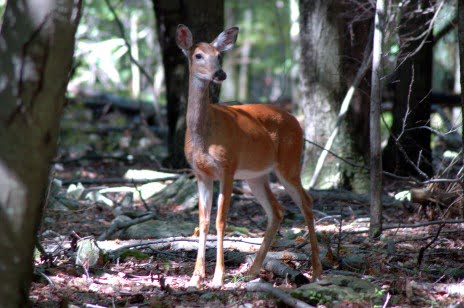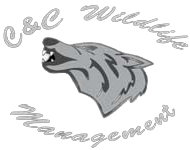DEER
The white-tailed deer (Odocoileus virginianus), also known as the Virginia deer, is a medium-sized deer found throughout most of the continental United States, southern Canada, Mexico, Central America and northern portions of South America as far south as Peru. The species is most common east of the American cordillera, and is absent from much of the western United States, including Nevada, Utah and California. It does, however, survive in the Northern and Canadian Rocky Mountain regions of United States and Canada, and in the Willamette Valley and Columbia River delta of Oregon and Southwestern Washington (endangered). There are also populations of white-tailed deer that inhabit the mountain forests of Arizona, New Mexico, and West Texas extending into Mexico. As a result of introductions, white-tailed deer are found also in localized areas of northern Europe. White-tailed deer are generalists and can adapt to a wide variety of habitats. Although most often thought of as forest animals depending on relatively small openings and edges, white-tailed deer can equally adapt themselves to life in more open savanna and even sage communities as in Texas and in the Venezuelan llanos region.
The deer can be recognized by the characteristic white underside to its tail, which it shows as a signal of alarm by raising the tail during escape. The male (also known as a buck) usually weighs from 60 to 100 kg (130 to 220 pounds) but, in rare cases, animals in excess of 160 kg (350 pounds) have been recorded. The female (doe) usually weighs from 40 to 60 kg (90 to 130 pounds), but some can weigh as much as 75 or 80 kg (165 to 175 pounds). The deer’s coat is a reddish-brown in the spring and summer, and turns to a grey-brown throughout the fall and winter. Only the mature males have antlers. Antlers begin to grow in early spring, covered with a highly vascularised tissue known as velvet. Bucks shed their antlers when all females have been bred, usually in late December or January. Females enter oestrus, colloquially called the rut, in the fall, normally in late October or early November, triggered mainly by declining photoperiod. Sexual maturation of females depends on population density. Females can mature in their first year, although this is unusual and would occur only at very low population levels. Most females mature at one or, sometimes, two years of age. Males compete for the opportunity of breeding females. Sparring among males determines a dominance hierarchy. Bucks will attempt to copulate with as many females as possible, losing physical condition since they barely eat or rest during the rut. The general geographical trend is for the rut to be shorter in duration at increased latitude. Females give birth to one or two spotted young, known as fawns in mid to late spring, generally in May or June. Fawns lose their spots during the first summer and will weigh from 20 to 35 kg by the first winter. Male fawns tend to be slightly larger and heavier than females. The deer can be recognized by the characteristic white underside to its tail, which it shows as a signal of alarm by raising the tail during escape. The male (also known as a buck) usually weighs from 60 to 100 kg (130 to 220 pounds) but, in rare cases, animals in excess of 160 kg (350 pounds) have been recorded. The female (doe) usually weighs from 40 to 60 kg (90 to 130 pounds), but some can weigh as much as 75 or 80 kg (165 to 175 pounds). The deer’s coat is a reddish-brown in the spring and summer, and turns to a grey-brown throughout the fall and winter. Only the mature males have antlers. Antlers begin to grow in early spring, covered with a highly vascularised tissue known as velvet. Bucks shed their antlers when all females have been bred, usually in late December or January. Females enter oestrus, colloquially called the rut, in the fall, normally in late October or early November, triggered mainly by declining photoperiod. Sexual maturation of females depends on population density. Females can mature in their first year, although this is unusual and would occur only at very low population levels. Most females mature at one or, sometimes, two years of age. Males compete for the opportunity of breeding females. Sparring among males determines a dominance hierarchy. Bucks will attempt to copulate with as many females as possible, losing physical condition since they barely eat or rest during the rut. The general geographical trend is for the rut to be shorter in duration at increased latitude. Females give birth to one or two spotted young, known as fawns in mid to late spring, generally in May or June. Fawns lose their spots during the first summer and will weigh from 20 to 35 kg by the first winter. Male fawns tend to be slightly larger and heavier than females.

